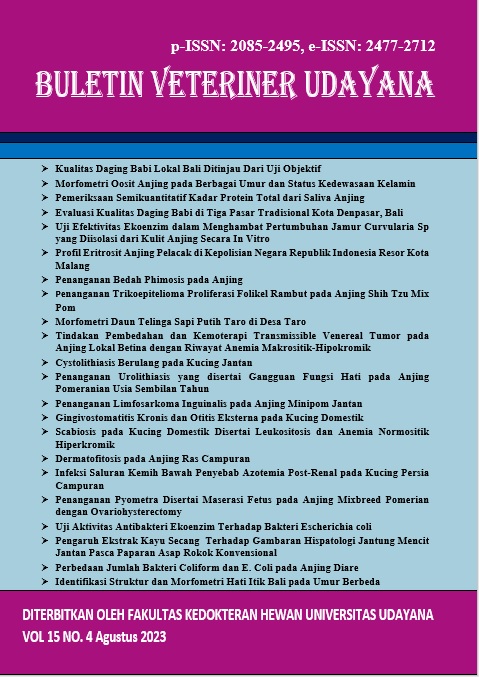SURGICAL TREATMENT OF PHIMOSIS IN DOGS
Abstract
Phimosis is a condition in which the male animal cannot remove the penis. This disease can be congenital or acquired. A male dog, mix Kintamani, named Dipo, aged 5 months and weighing 6 kg, has urinating problems. The owner has explained that the case dog cannot urinate like other dogs in general. Clinical examination showed the dog had a small opening (orifice). The hematological examination of the blood showed a decrease in the value of hemoglobin and platelets. The case dog was diagnosed with phimosis with a good ??prognosis. Surgical treatment was performed in the form of enlarging the opening of the sheath (orifice). The premedication used 0.5 ml atropine sulfate subcutaneously with a combination of 0.6 ml of ketamine and 0.6 ml of xylazine anesthesia intravenously. The postoperative treatment used antibiotics of 0.1 ml kg/BW Amoxycilin intravenously on the first day and followed by the antibiotic ointment of 0.1% Gentamicin Sulphate for the suture wound. Anti-inflammatory of 1ml/10kg/BW Tolfenamide acid was injected intramuscularly. The results of surgery and therapy showed that the case dog was comfortable when urinating. The surgical wound has healed on the fifteenth day. It is recommended for owners not to underestimate this condition and to have their animals immediately examined by a veterinarian for further treatment.
Downloads
References
Freitas PMC, Luz MR, Paraguassu AO, Barbosa BC. 2019. Particularities in surgeries of the canine reproductive system. Rev. Bras. Reprod. Anim. 43(2): 346-355.
Hu XY, Luan L, Guan W, Shi J, Zhao YB, Fan HG. 2017. Tolfenamic acid and meloxicam both provide an adequate degree of postoperative analgesia in dogs undergoing ovariohysterectomy. Vet. Med. 62(06): 333–341.
Lauren RM, Joe GH. 2009. Phimosis in cats: 10 cases (2000–2008). J. Am. Anim. Hosp. Assoc. 45(6): 277–283.
Machphail CM.2014 Cirurgia do trato reprodutivo do macho. In: Fossum, T. W. Cirurgia de pequenos animais. 4. Ed. Rio de Janeiro: Elsevier. Pp. 846-848.
Olsen D, Salwei R. 2001. Surgical correction of a congenital preputial and penile deformity in a dog. J. Am. Anim. Hosp. Assoc. 31: 187-192.
Papich MG. 2011. Saunders handbook of veterinary drugs small and large animal. 3 rd ed. United State of Amerika (USA): Edinburgh London Elsevier.
Parra JC, Gallo GC, Leal LM. 2021. Congenital phimosis in a dog. Uningá Rev. J. 36: 2178-2571.
Papazoglou L, Kazakos GM. 2002. Surgocal conditions of the canine penis and prepuce. Aristotle University of Thessaloniki Thessaloniki, Greece. Compedium. 24(3): 205-217.
Puerta B, Baines S. 2012. Surgical diseases of the genital tract in male dogs: Penis and prepuce. Comp. Anim. Pract. 34: 128-132.
Sinno H, Malholtra M, Lutfy J. 2011. Topical application of complement C3 in collagen formulation increases early wound healing. J. Dermatol. Treat.24(2): 141–147.
Vadalia JV, Patel AM, Kumar V. 2014. Surgical management of congenital phimosis in pup. Intas. Polivet. 1(1): 160-162.
Volkmam D. 2012. Phimosis. Eric Monnet, Ed. Small Animal soft tissue surgery, United States: Iowa State University Press. Pp. 71.
Valming A, Wallace Ml, Ellison GW. 2019. Clinical characteristics, classification, and surgical outcome for kittens with phimosis: 8 cases (2009–2017). J. Am. Vet. Med. Assoc. 255(9): 1039-1046.





